DEA-linked deaths show faults in Central American drug plan
by Allen Hines Gunfire erupted from helicopters provided by the US State Department and carrying Drug Enforcement Agency (DEA) trainers and Honduran police on May 11. The shots killed four Hondurans described by locals as fisherpeople. Two of them were pregnant.
- Who did the shooting is unclear. US officials said the fisherpeople were caught in the crossfire of an anti-drug mission. About an hour prior to the shooting, the DEA-sponsored anti-drug unit had seized a shipment of drugs in the Mosquitia region of Honduras. When another passing boat shot at the helicopters later on, they pursued but shot at the wrong boat, killing the fisherpeople. Injured survivors include Lucio Adan Nelson, age 22, and Wilmer Lucas Walter, age 14.
Witnesses said DEA agents, part of the specialized Foreign-deployed Advisory Support Team (FAST), had fired their weapons, a claim the US State Department denies. According to a report from Rights Action for which the human rights group interviewed eyewitnesses, at least 10 tall, light-skinned English speakers got off a helicopter involved in the shooting to collect evidence . The killings have sparked outrage in the isolated coastal region. Government offices were burned, and residents have demanded the agency's expulsion. The conflicting reports have prompted demands for a thorough investigation. “To keep an act of terror covered up in the midst of media confusion was always a strategy of psychological warfare, a special chapter of state terrorism,” COFADEH, a Honduran human rights group, wrote in a statement days after the incident. “We should not accept this.” Violence has been endemic to the US drug war since the first strikes at growers and traffickers (and innocent farmers and poor people) in the Andes. Felipe Calderon's dispatching the military to the streets of Mexico in 2006, too, has resulted in tens of thousands of deaths. But, according to the Obama administration, the drug war in Central America was supposed to be different. Where past anti-drug plans have employed overtly militarized policing and interdiction efforts, the largest parts of the State Department's Central American Regional Security Initiative (CARSI) emphasize vetted police units, community policing and increasing cooperation among police, judges and prosecutors. A May 2011 Congressional Research Service report noted the shift toward “institution building” as the driver of drug war policy under the Obama Administration. Specifically, as part of CARSI, the FAST units create and train vetted host-country anti-drug units, which currently exist in Guatemala, Honduras, El Salvador and Panama. The FAST training is intended to build police capability to track and arrest drug traffickers. According to Chief of Operations Thomas Harrington, the role the DEA plays within CARSI is to use its “technical expertise, responsibility, and experience to partner with host nation law enforcement to achieve the common goals and objectives related to the dismantling and disrupting of major DTOs [drug trafficking organizations] and their networks.” However, the killings of innocent Hondurans shatter the veneer of institution building that the State Department maintains around CARSI and threaten to rupture the myth that the US is investing in stability and democracy in Central America, rather than in militarized drug-control strategies that have been proven failures. The DEA agents aboard the State Department choppers in Honduras were part of the FAST program, established in 2005 to support and train the Afghan anti-drug unit to find and seize drugs and dismantle trafficking organizations. The FAST agents in Afghanistan featured in a 2009 ABC News report look a lot like US soldiers, equipped with heavy weapons and grenades and dressed in military-style combat gear. Though Afghanistan produced 90 percent of the world's opium in 2008, the supposed success of the FAST program led to its expansion that year to countries in the Western Hemisphere. The units, according to Thomas Harrington, have deployed to Belize, Honduras, Guatemala and Panama. And FAST agents have taken part in several gunfights, including another this month in Honduras on May 6. In accordance with the 1976 Mansfield Amendment, foreign-deployed agents do not have authority to fire their weapons except “to protect life or safety in certain exigent circumstances.” Still, these units, which the New York Times has likened to commandos, composed primarily of former members of the military, are deployed to areas where pitched battles and exigent circumstances are likely to occur, increasing the likelihood of further shootouts. In addition, the training received by FAST agents may better equip them to advise and participate in military operations than to train and support civilian law enforcement. Following a tradition of military training that goes back to Operation Snowcap in the 1980s, DEA's original FAST unit received training at Fort Benning, a military base infamous for its School of the Americas. In 2011, the FAST program was a subject at the National Defense Industrial Association's symposium on Special Operations and Low-Intensity Conflict. The presentation, given by FAST Section Chief and former Navy SEAL Richard Dobrich, showcased the unit's training supported by US Special Operations Command (SOCOM), known for its covert, offensive operations. The trainings mentioned on the presentation's slideshow included “close-quarter combat shooting” and “land warfare.” The killings of the Honduran fisherpeople show the Central American Regional Security Initiative as less clean than some observers have suggested it is and that its emphasis on police training, as opposed to military training, may be largely insignificant when both result in extrajudicial killings. Concerns are high that the hybridization of the military and police through CARSI may result in violence similar to what other counterdrug efforts have produced. Originally published on Upside Down World UPDATE: Read a press release and initial report from arecent Rights Action/Alliance for Global Justice delegation to the region documenting direct US participation in this massacre

 "I am a CISPES supporter because continuing to fight for social justice and a more people-centered country means continuing the dream and sacrifice of thousands of my fellow Salvadorans who died for that vision.” - Padre Carlos, New York City
"I am a CISPES supporter because continuing to fight for social justice and a more people-centered country means continuing the dream and sacrifice of thousands of my fellow Salvadorans who died for that vision.” - Padre Carlos, New York City

